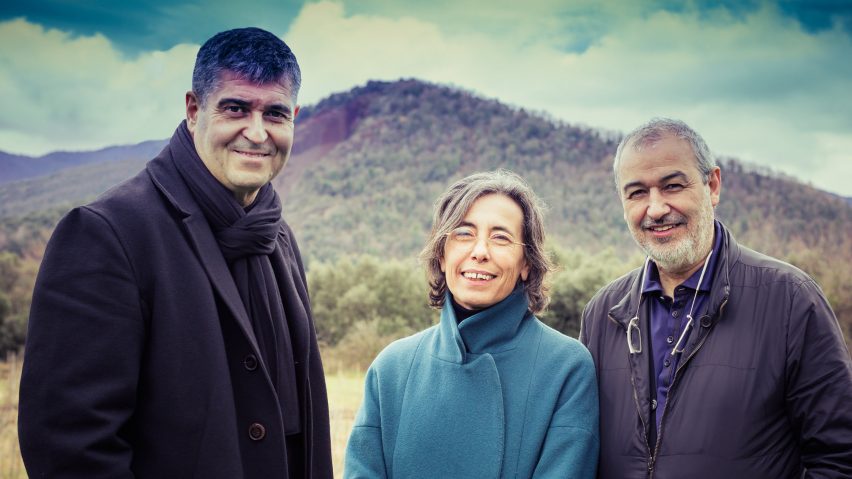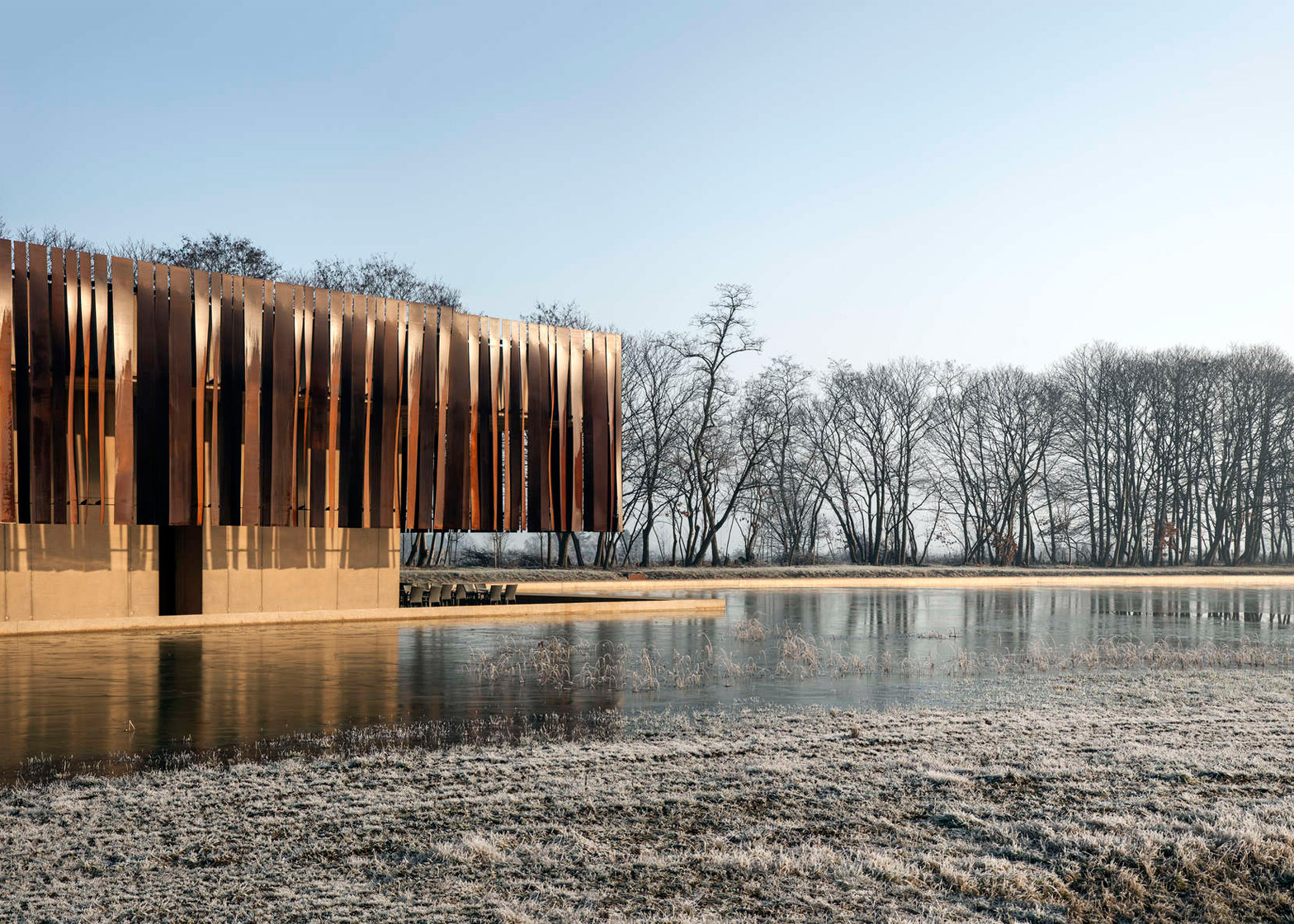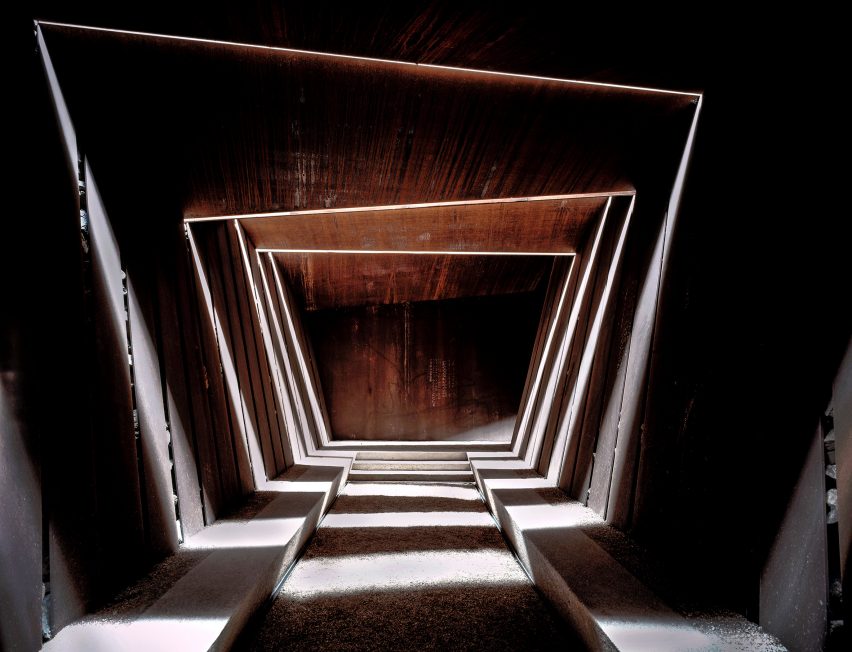
RCR Arquitectes wins Pritzker Prize 2017
Rafael Aranda, Carme Pigem and Ramon Vilalta of Spanish studio RCR Arquitectes have been named as the 2017 laureates of the Pritzker Prize, architecture's most prestigious award.
The three Catalan architects are the 39th recipients of the Pritzker Prize, and will receive a $100,000 (£81,000) grant and bronze medallion at a ceremony held at the State Guest House in Tokyo on 20 May 2017.
Aranda, Pigem and Vilalta founded their practice RCR Arquitectes in 1988. The studio, which came in at number 249 on the Dezeen Hot List, is based in Olot in Spain's Catalonia Region.
This is the first time that three architects have been awarded the Pritzker Prize, and just the second time the award has gone to laureates from Spain – with the first being Rafael Moneo in 1996.

"Aranda, Pigem and Vilalta have had an impact on the discipline far beyond their immediate area," said the Pritzker jury, which was chaired by Australian architect Glenn Murcutt.
"Their works range from public and private spaces to cultural venues and educational institutions, and their ability to intensely relate the environment specific to each site is a testament to their process and deep integrity."
The group recently completed a tinted concrete and steel crematorium in Holsbeek, Belgium, and collaborated on an entrance to the Garrotxa Volcano Park in Les Preses near their home town of Olot.
The park is one of a number of projects the trio has completed in Olot, alongside the Les Cols Restaurant Marquee (2011), the Barberí Laboratory (2008) and the Tossols-Basil Athletics Track (2000)
Among their other notable projects are the Bell–Lloc Winery in Girona and Sant Antoni – Joan Oliver Library, Senior Citizens Center and Cándida Pérez Gardens in Barcelona – both completed in 2007.

"They've demonstrated that unity of a material can lend such incredible strength and simplicity to a building," said Murcutt.
"The collaboration of these three architects produces uncompromising architecture of a poetic level, representing timeless work that reflects great respect for the past, while projecting clarity that is of the present and the future."
The architects discuss how their approach to architecture has emerged over almost three decades of collaboration, in a video made by Pritzker.
"When we begin a project, we are very interested in visiting the place," says Carme Pigem. "We are used to 'reading' the place as if it spoke to us with its own alphabet – an alphabet established between the site and us."
"It is also very important to study what we are to do there. We don't like to start with a typology or assumptions," she added.
It is this particular approach to site specificity that won the group this year's Pritzker Architecture Prize.
The architects discuss their approach to architecture in this film
"We live in a globalised world where we must rely on international influences, trade, discussion, transactions," said the jury. "But more and more people fear that because of this international influence we will lose our local values, our local art, and our local customs. Rafael Aranda, Carme Pigem and Ramon Vilalta tell us that it may be possible to have both."
"They help us to see, in a most beautiful and poetic way, that the answer to the question is not 'either/or' and that we can, at least in architecture, aspire to have both; our roots firmly in place and our arms outstretched to the rest of the world."
The international award, which is modelled on the Nobel Prize, was set up in 1979 to honour the work of living architects.
Last year's winner was Chilean architect and Venice Biennale curator Alejandro Aravena. Frei Otto, Rem Koolhaas, Zaha Hadid and Toyo Ito are among past recipients of the annual award.
Read the full citation from the Pritzker Prize jury:
Rafael Aranda, Carme Pigem and Ramon Vilalta, three architects who have worked closely together for almost 30 years in a deliberate and thoughtful approach to architecture are recognised with the 2017 Pritzker Architecture Prize. Their works admirably and poetically fulfil the traditional requirements of architecture for physical and spatial beauty along with function and craftsmanship, but what sets them apart is their approach that creates buildings and places that are both local and universal at the same time.
They established their office, called RCR for their three first names, in Olot, their hometown in the Catalonian region in the northeast of Spain, resisting the call of the metropolis in favour of remaining closely connected to their roots. The process they have developed is a true collaboration in which neither a part nor whole of a project can be attributed to one partner. Their creative approach is a constant intermingling of ideas and continuous dialogue.
All their works have a strong sense of place and are powerfully connected to the surrounding landscape. This connection comes from understanding – history, the natural topography, customs and cultures, among other things – and observing and experiencing light, shade, colours and the seasons. The siting of buildings, the choice of materials and the geometries used are always intended to highlight the natural conditions and pull them into the building.
The Bell-Lloc Winery (2007), in the town of Palamós, near Girona, Spain, for example, a building embedded in the ground, is about the soil that produces the grapes, the cool dark cellars needed for the ageing of wine and the colour and weight of the earth. The extensive use of recycled steel fuses the building with the earth and the openings between the steel slats allow in hints of light.
The marquee (2011) creating an outdoor dining and event space at Les Cols Restaurant in Olot is another example of the fusion of landscape and minimal modern materials to create a useful and popular venue. Some have said that they are reminded of places for countryside meals with family and friends. The space fits into a valley carved out in the landscape by the architects. Strong walls of volcanic stone support a light weight and transparent polymer roof to protect against rain and sun. The furniture and vertical hanging blinds that can sub-divide the space are also of clear plastic, which puts the emphasis on food, festivities and the natural setting.
In other works, such as their own office (2007), a former foundry built at the beginning of the 20th century, the juxtaposition of past and present is undertaken in a most thoughtful, clear and respectful way. Just as exterior and interior are closely intertwined in their works, so are new and old. All of the original industrial building that could remain, was left 'as is'.
By adding new elements only where needed and in contrasting materials, the architects demonstrate their love for both tradition and innovation. The resulting building, which they call Barberí Laboratory, is comprised of varied, flexible and highly functional spaces. While Rafael Aranda, Carme Pigem and Ramon Vilalta have a deep sense and knowledge of history, they use materials and modern construction to create spaces that could not have been created before.
Community is another word that comes to mind when speaking of the work of Aranda, Pigem and Vilalta. Both in the bright and colourful nursery school in Besalú, Girona, El Petit Comte Kindergarten (2010) and the Sant Antoni – Joan Oliver Library, Senior Citizens Center and Cándida Pérez Gardens in Barcelona (2007), those who will inhabit the buildings are at the forefront of their concerns. It is obvious when seeing the rainbow colours of the tubes that define the exterior of the school that this is for children’s enjoyment, creativity, and fantasy. The library, a commission won through a competition, as are many of RCR's projects, is situated within the fabric of an existing city block, is a needed amenity in this busy part of Barcelona. Visitors are welcomed into the library. The richness and variety of spaces invite exploration and are casual enough to create a relaxed and friendly atmosphere. The library also acts as a gateway to an interior courtyard. The senior citizens centre looks onto this space where children, library goers, neighbours and seniors can mingle.
The architects have also tackled important works outside their home in Catalonia. They have built in Belgium and France. The Soulages Museum (2014) in Rodez, France, for example, houses the works of the abstract painter Pierre Soulages and forms a symbiosis with the artist, who seems to paint with light. This building of steel and strong geometric shapes cantilevers over the site, seeming to defy gravity and like many of their other works is in dialogue with the landscape. The architects have sought to create “a space that is as close to nature as possible, enhancing our sense that we are part of it.”
In this day and age, there is an important question that people all over the world are asking, and it is not just about architecture; it is about law, politics, and government as well. We live in a globalised world where we must rely on international influences, trade, discussion, transactions, etc. But more and more people fear that, because of this international influence, we will lose our local values, our local art, and our local customs. They are concerned and sometimes frightened. Rafael Aranda, Carme Pigem and Ramon Vilalta tell us that it may be possible to have both. They help us to see, in a most beautiful and poetic way, that the answer to the question is not 'either/or' and that we can, at least in architecture, aspire to have both; our roots firmly in place and our arms outstretched to the rest of the world. And that is such a wonderfully reassuring answer, particularly if it applies in other areas of modern human life as well.
Each building designed by these architects is special and is uncompromisingly of its time and place. Their works are always the fruit of true collaboration and at the service of the community. They understand that architecture and its surroundings are intimately intertwined and know that the choice of materials and the craft of building are powerful tools for creating lasting and meaningful spaces. For these reasons, exemplified in all their built work, and for their ability to express the local, but also the universal, uniting us with one another through architecture, Rafael Aranda, Carme Pigem and Ramon Vilalta are awarded the 2017 Pritzker Architecture Prize.